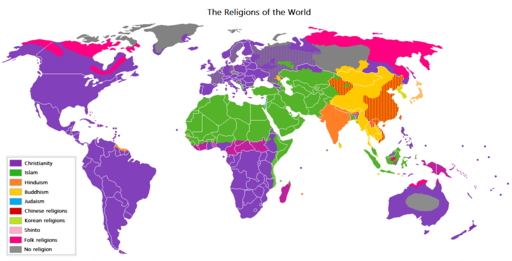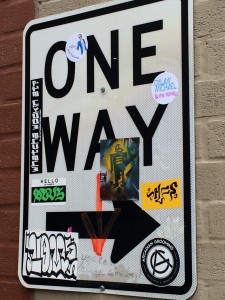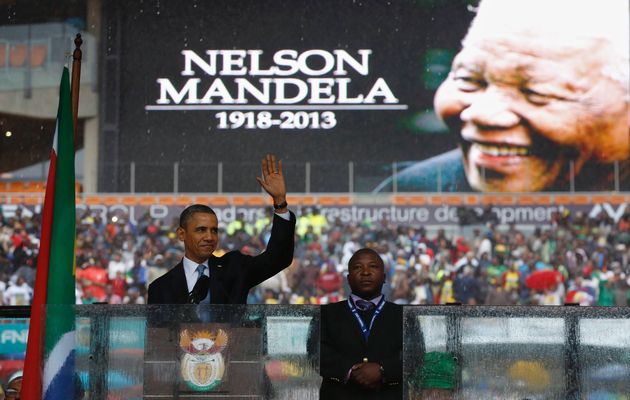 While discussions of “World Religions” often attempt to encourage appreciation of human diversity, these presentations have become the focus of scholarly critiques because of the harm that they cause. Such presentations appear to provide a clear way of describing the world (as illustrated in the map above), but the assumptions behind them often serve to promote European dominance that people present as simple descriptions. A recent animated presentation on Business Insider illustrating the spread of the five major world religions becomes the object of a range of critiques. Continue reading “The Harm of World Religions”
While discussions of “World Religions” often attempt to encourage appreciation of human diversity, these presentations have become the focus of scholarly critiques because of the harm that they cause. Such presentations appear to provide a clear way of describing the world (as illustrated in the map above), but the assumptions behind them often serve to promote European dominance that people present as simple descriptions. A recent animated presentation on Business Insider illustrating the spread of the five major world religions becomes the object of a range of critiques. Continue reading “The Harm of World Religions”
The Moves We Make

Prompted by the discussion surrounding Rachel Dolezal’s NAACP resignation, this series of posts is about how and when we take performativity seriously… and when it bows to interests in historical or experiential specificity.
If I’m counting, I’ve read exactly one smart thing about Rachel Dolezal on the internet—Adolph Reed Jr.’s “From Jenner to Dolezal: One Trans Good, the Other Not So Much” (thanks, Craig Martin, for directing my attention to it). In the piece, Reed says, among other things, that the distinction between trans people’s “involuntary” decision and Dolezal’s “active choice” where self-identification is concerned “is mind-bogglingly wrong-headed, but it is at the same time thus deeply revealing of the contradictoriness and irrationality that undergird so much self-righteous identitarian twaddle.” But wait, I’m getting ahead of myself. I need to explain why I think we should still even be talking about Rachel Dolezal, right? Continue reading “The Moves We Make”
Look How Tall You Are!
 The ease with which identity is presumed to be an inner trait projected outward is pretty easy to document, which makes critiquing it something less than a challenge. For example, I thought about writing a post on the new film “Inside Out” and the popular folk understanding of identity as being an internal quality only subsequently expressed outwardly, such that the social interaction is the effect of a prior and private sentiments.
The ease with which identity is presumed to be an inner trait projected outward is pretty easy to document, which makes critiquing it something less than a challenge. For example, I thought about writing a post on the new film “Inside Out” and the popular folk understanding of identity as being an internal quality only subsequently expressed outwardly, such that the social interaction is the effect of a prior and private sentiments.
But that just seemed too easy.
And, besides, the film seems kind’a fun. Continue reading “Look How Tall You Are!”
Meet Me in St. Louis: The Simpler Side of Identity Politics

When I was a young child, I lived in the third largest city in Missouri – Springfield – and I hadn’t really traveled much outside of the region. At the time I loved to look at atlases and read maps, and I distinctly remember the day that I came across a factoid indicating that the largest city in Missouri was Kansas City (a city I’d never seen), with St. Louis a close second.
I was livid, convinced there was a mistake, for as we all know, being bigger is better, and St. Louis was clearly superior because I’d a) been there, and b) had fun there. In other words, my positive affiliations with St. Louis, while founded on nothing more than visiting some tourist draws and swimming in a motel pool, were enough for me to align my own identity with the city and therefore create strong positive, and in the context, illogical opinions about it. (Ironically, I now live in Kansas City). Continue reading “Meet Me in St. Louis: The Simpler Side of Identity Politics”
What’s in Your Nacho Cheese?
 Being Super Bowl Sunday, it is time to think about that staple of Super Bowl parties, nacho cheese. Despite its ubiquity as a term in our society, no official definition exists, according to a recent interview on Marketplace (the economics radio program) with the host Kai Ryssdal and his guest Venessa Wong. You can listen to the interview below. Continue reading “What’s in Your Nacho Cheese?”
Being Super Bowl Sunday, it is time to think about that staple of Super Bowl parties, nacho cheese. Despite its ubiquity as a term in our society, no official definition exists, according to a recent interview on Marketplace (the economics radio program) with the host Kai Ryssdal and his guest Venessa Wong. You can listen to the interview below. Continue reading “What’s in Your Nacho Cheese?”
Constitution by Description
 “There’s an assumption … that a person’s race is fixed…” — so opens a report this morning, on National Public Radio, of controlled, empirical evidence to the contrary, indicating the manner in which social cues and assumptions of their significance (e.g., Have you been to prison? Did you die of liver failure due to alcohol?) prompt people to ascribe this or that identity, such as a race, to other people…, and even to themselves. Continue reading “Constitution by Description”
“There’s an assumption … that a person’s race is fixed…” — so opens a report this morning, on National Public Radio, of controlled, empirical evidence to the contrary, indicating the manner in which social cues and assumptions of their significance (e.g., Have you been to prison? Did you die of liver failure due to alcohol?) prompt people to ascribe this or that identity, such as a race, to other people…, and even to themselves. Continue reading “Constitution by Description”
Group Fiction

When the Huffington Post included “The ‘Nones’ Get Organized” in its list of the of Top Ten Religion Stories for 2013, the description illustrates further the problems with much of our discourse. Not only does the account switch too easily from “Nones” to the organizers of the “Sunday Assembly,” a congregational gathering focusing on nontheists, but the account also illustrates the absence of commonality, even among a subset of the “Nones,” while still discussing the “Nones” as if they form a group to be organized. Continue reading “Group Fiction”
Signs, Signs, Everywhere a Sign
 I assume you’ve heard the reaction to the sign language interpreter at the Nelson Mandela memorial a few days ago — the fellow who wasn’t signing anything meaningful. It’s a great example, really, of how signification works. Continue reading “Signs, Signs, Everywhere a Sign”
I assume you’ve heard the reaction to the sign language interpreter at the Nelson Mandela memorial a few days ago — the fellow who wasn’t signing anything meaningful. It’s a great example, really, of how signification works. Continue reading “Signs, Signs, Everywhere a Sign”
The Social Has Effects
Just because we collectively make things happen — things that provide the conditions in which we all live and move, like defining this as race or that as religion, or this as meaning stop and that as meaning go — doesn’t make those conditions or our actions within them fake.
On the Spot with Monica Miller
“On the Spot” backs members of Culture on the Edge into a corner to talk about their backgrounds, their ongoing work, and what might be gained by an alternative understanding of how identity works.
 Q: Identity and identification are words the members of Culture on the Edge are using to stand in for two different, and likely opposed, scholarly approaches to the study of who we see ourselves and others as being; whereas the first presumes a stable inner quality or sentiment only later projected outward into the public world, the latter starts with a series of public practices and social situations that are eventually interiorized. In your own research specialty – Hip Hop culture and rap music in particular, but also the wider field of the study of African American religion — can you illustrate the difference between these two approaches? Continue reading “On the Spot with Monica Miller”
Q: Identity and identification are words the members of Culture on the Edge are using to stand in for two different, and likely opposed, scholarly approaches to the study of who we see ourselves and others as being; whereas the first presumes a stable inner quality or sentiment only later projected outward into the public world, the latter starts with a series of public practices and social situations that are eventually interiorized. In your own research specialty – Hip Hop culture and rap music in particular, but also the wider field of the study of African American religion — can you illustrate the difference between these two approaches? Continue reading “On the Spot with Monica Miller”
